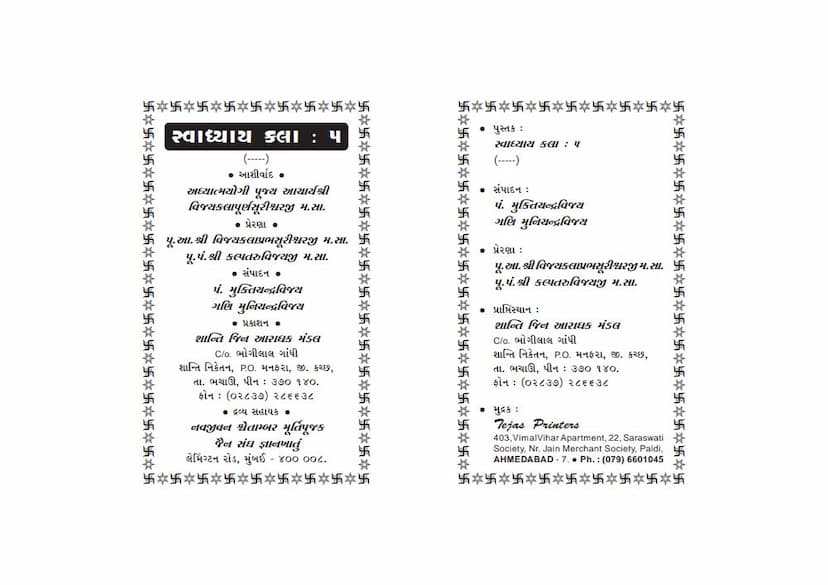Swadhyaya Kala 05
Added to library: September 2, 2025

Summary
This document, "Swadhyaya Kala 05" by Muktichandravijay and Munichandravijay, published by Shanti Jina Aradhana Mandal, is a Jain text that focuses on the principles and practices of Yoga as described in the Yogashastra by Acharya Hemchandracharya. The text is divided into several "Prakashas" (chapters or sections), each detailing different aspects of Jain philosophy and practice.
Here's a breakdown of the key themes and content covered in the provided pages:
Overall Structure and Purpose:
- Compilation of Yogic Principles: The text aims to elucidate the path to liberation (moksha) through the practice of Yoga, as understood within the Jain tradition.
- Emphasis on Self-Discipline and Knowledge: It highlights the importance of right knowledge (samyak-gyana), right faith (samyak-darshana), and right conduct (samyak-charitra) as the foundation for spiritual progress.
- Practical Guidance: The text offers detailed explanations of various vows (vratas), principles, and practices that householders and ascetics can follow.
Key Content Areas:
-
Introduction to Yoga (Page 2):
- The text begins with salutations (namaskara) to the Tirthankaras, particularly Lord Mahavira, acknowledging their role as guides on the path of Yoga.
- It defines Yoga as a means to overcome all calamities, a sharp axe to cut down karmic ties, and a powerful mantra for liberation.
- The efficacy of Yoga is highlighted by mentioning historical figures like Bharata and Marudeva, who achieved great spiritual heights through its practice.
- The core principles of Jainism, Ratnatraya (Three Jewels) – Right Knowledge, Right Faith, and Right Conduct – are identified as the cause and essence of Yoga.
-
Right Conduct (Samyak-charitra) (Pages 2-4):
- Ahimsa (Non-violence): This is presented as the foremost vow (Maha-vrata), encompassing the protection of all sentient beings (trasa and sthavara). The text emphasizes the ethical implications of causing harm.
- Satya (Truthfulness): Defined as speaking pleasant, beneficial, and truthful words. It cautions against speaking unpleasant truths.
- Asteya (Non-stealing): Explained as refraining from taking what is not given.
- Brahmacharya (Celibacy/Chastity): Described as the control of mind, speech, and body in relation to sensual pleasures, with an eighteen-fold classification.
- Aparigraha (Non-possession/Non-attachment): Defined as avoiding excessive attachment to worldly possessions, emphasizing the mind's tendency towards attachment.
- Five Samitis (Carefulness) and Three Guptis (Control): The text details the five careful actions (Irya, Bhasha, Aishana, Adana, Utarga) and three controls (mind, speech, body) that are crucial for maintaining pure conduct. It explains how these practices contribute to the refinement of character.
-
Householder's Duties and Vows (Pages 4-16):
- Samytaktva (Right Faith): The foundation of the path, characterized by right belief in God (Deva), Guru, and Dharma, and the absence of wrong beliefs.
- Anuvratas (Minor Vows): The five minor vows for householders are elaborated, including Ahimsa, Satya, Asteya, Brahmacharya, and Aparigraha, with specific practices and prohibitions.
- Guṇa Vratas (Qualitative Vows) and Shiksha Vratas (Training Vows): The text then delves into the supplementary vows that enhance spiritual practice for householders:
- Dig-virati (Directional Vow): Limiting one's activities to specific directions.
- Bhoga-upabhoga Virati (Vow of Limited Enjoyment): Restricting the consumption of consumables and enjoyables.
- Anartha-danda Virati (Abstinence from Useless Acts): Avoiding actions that are harmful or unnecessary.
- Practices for Householders: It outlines the daily routine of a virtuous householder, including waking up early, prayer, contemplation, respecting elders and teachers, engaging in righteous activities, and practicing meditation.
- The Dangers of Wrong Associations and Actions: The text strongly condemns practices like drinking alcohol (madya-pana), consuming meat (mamsa-bhakshana), and engaging in sensual misconduct. It details the negative consequences of these actions, including rebirth in hellish realms.
- The Importance of Asceticism and Renunciation: It praises the path of ascetics (munis) who have renounced worldly life and dedicated themselves to spiritual practices.
-
Dharma and Spiritual Practices (Pages 16-23):
- The Essence of Dharma: Dharma is presented as the most cherished companion and protector in life and death. It is the source of all virtues and the means to attain liberation.
- The Efficacy of Penance and Austerities (Tapa): The text emphasizes the power of various forms of penance (external and internal) to purify the soul and overcome karma.
- Mind Control and Meditation (Dhyana): The paramount importance of controlling the mind is stressed. Various meditation postures (asanas) and techniques are described, highlighting the role of concentration and equanimity in achieving spiritual progress.
- The Nature of Karma and Soul: It explains how actions (karma) bind the soul and how liberation is achieved through the destruction of karma.
- The Five Reflections (Bhāvanās): The text likely touches upon the importance of cultivating mental states like friendliness, joy, compassion, and equanimity.
-
The Path to Liberation (Pages 23-24):
- Attainment of the Soul: The ultimate goal is described as realizing the true nature of the soul, which is beyond the physical body and the cycle of birth and death.
- Destruction of Karma: Liberation is achieved through the complete annihilation of karmic particles that obscure the soul's inherent purity.
- The Role of Knowledge and Practice: The text reiterates that true liberation comes from the combination of right knowledge, right faith, and right conduct, practiced with unwavering devotion and discipline.
Key Takeaways:
The book "Swadhyaya Kala 05" serves as a guide to living a virtuous and spiritually progressive life according to Jain principles, with a strong emphasis on the practice of Yoga. It details the ethical framework of non-violence, truthfulness, non-stealing, chastity, and non-possession, and explains how these are cultivated through specific vows and practices. The text also underscores the importance of controlling the senses and the mind, engaging in ascetic practices, and the ultimate goal of realizing the pure, liberated soul.